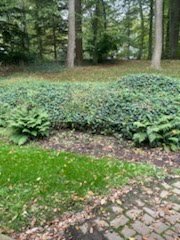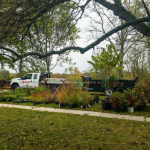Comprehensive Guide to Planting Hicks Yew Bushes
Popular evergreen shrub Hicks Yew is tall and thin and boasts rich green leaves. For building privacy screens, hedges, and even striking topiaries, it excels in all. A lovely addition to any landscape in the winter months, Hicks Yew keeps green all year long.
At Bates Landscaping Designing, we specialize in installing and designing landscapes. We’re highly knowledgeable about Hicks Yew and are happy to help you through the planting process.
What Makes Hicks Yew Unique?
Hicks Yew, also known as Taxus x media “Hicksii,” is a unique shrub with many desirable traits. It’s an evergreen, which means it maintains its green leaves all year long.
Even in winter, it continues growing tall and thin. It is ideal for confined areas or tall screens. This adaptable shrub serves many different uses, like:
Privacy Screens
Plant multiple privacy screens in a row to prevent undesired views and foster seclusion.
Hedges
Maintaining a modest height will help to create a natural, lovely border.
Foundation Plantings
Using these graceful shrubs can help to soften the appearance of the foundation of your house.
Ornamental Topiaries
Hicks Yew may become live sculptures with enough sculpting.
Growing zones 4 to 7 is where Hicks Yew excels and can thus manage both moderate summers and cold winters.
Planting Your Hicks Yew: A Step-by-Step Guide
Timing is key when planting Hicks Yew. The best times are during the cooler months: fall, winter, or spring. Avoid planting during the hot summer months, as this can stress the young shrubs.
Choosing the Right Spot
Hicks Yew is adaptable, but it thrives in specific conditions. It prefers a spot that gets full sun, but it can also tolerate partial shade. The soil should drain well, meaning water doesn’t pool around the roots.
This plant also likes slightly acidic soil, ideally with a pH between 6.0 and 7.0. If you’re not sure about your soil, you can test it with a simple kit from your local garden center.
If you’re planting multiple shrubs to create a hedge, space them about three feet apart. This gives each shrub enough room to grow and fill in the space.
Planting Your Hicks Yew
Ready to plant? Follow these steps for great results:
Digging the Perfect Home
Create a hole twice as wide as the root ball but only as deep as the container it came in. The top of the roots should peek out about an inch above the ground.
Freeing the Roots
Take the Hicks Yew out of its container. Gently loosen the roots with your fingers to encourage them to spread out.
Planting with Care
Put the Hicks Yew in the hole, making sure it stands up straight. Fill in the hole with soil, gently pressing it around the roots to remove air pockets.
Watering
Give your new plant a long, slow drink of water. This helps the soil settle around the roots and keeps them from drying out.
Mulching for Protection
Spread a layer of mulch around the plant but not touching the trunk. Think of it as a cozy blanket for the roots, keeping them cool and moist.
By following these simple steps, your Hicks Yew will settle into its new home and start to grow. With a little care, it will soon reward you with its beauty and hardiness.
Caring for Your Hicks Yew: Keeping Them Healthy and Happy
Caring for these plants is surprisingly easy, but a little attention goes a long way in keeping them healthy and beautiful.
Watering Wisely
Hicks Yew likes a good drink, but it doesn’t like to sit in water. Water your shrubs deeply, but let the top few inches of soil dry out before watering again.
This helps prevent root rot, a common problem caused by too much moisture. During hot, dry periods, you may need to water more often.
Pruning for Shape and Size
Hicks Yew might be a slow grower, but regular trims keep it looking sharp. Prune your shrubs in late winter or early spring before they start growing again. Use sharp shears to make clean cuts and avoid hurting the plant.
You can shape your Hicks Yew in many ways. A neat, squared-off hedge or a more natural, flowing look are both popular options. The choice is yours.
Feeding Your Shrubs

In early spring, give your Yew a boost with a slow-release fertilizer. This provides the nutrients it needs for healthy growth throughout the season. Follow the instructions on the fertilizer package for the proper amount to use.
Pests and Diseases: Staying Vigilant
Hicks Yew is generally resistant to pests and diseases, but it’s important to keep an eye out for any signs of trouble. If you notice any discoloration, wilting, or unusual growths, consult with a gardening expert or your local nursery for advice. Early detection and treatment can often save your shrubs.
Extra Care Tips
In colder climates, protect your plant from winter burn by wrapping them with burlap or a similar material. This shields them from harsh winds and sun, which can dry out the foliage.
Remember, overwatering is a common mistake with this shrub. It’s better to underwater than overwater, as they are more tolerant of dry conditions than soggy roots.
By following these simple care tips, you can ensure that your shrubs thrive for years to come, adding beauty and privacy to your landscape.
Do you need help designing and installing a stunning landscape with Hicks Yew? Contact Bates Landscaping today.
We’ll work with you to create a custom plan that perfectly suits your needs and preferences. Our experienced team will handle all the details, from plant selection and placement to ongoing maintenance.
Contact Bates Landscaping for Superior Hicks Yew Care
Hicks Yew is a truly versatile and low-maintenance evergreen shrub. It offers year-round beauty, privacy, and structure to any landscape. Whether you’re dreaming of a lush privacy hedge, a formal border, or a unique topiary, Hicks Yew is an excellent choice.
At Bates Landscaping, we’re passionate about creating outdoor spaces that bring you joy. We have the expertise and experience to help you design and install a landscape that perfectly suits your needs and style.
Contact us today for a consultation. We’ll guide you through every step of the process, ensuring your complete satisfaction and a landscape you’ll love for years to come.






